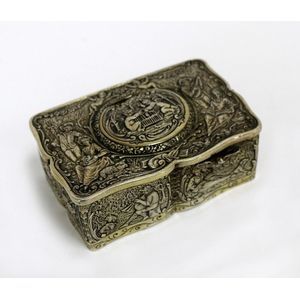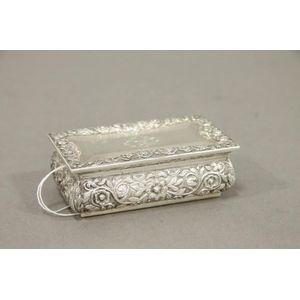Victorian-style Sterling Silver Snuff Box, London 1973
You must be a subscriber, and be logged in to view price and dealer details.
Subscribe Now to view actual auction price for this item
When you subscribe, you have the option of setting the currency in which to display prices to $Au, $US, $NZ or Stg.
- Engine Turned - Engine turning is a decorative technique used on metal surfaces to create intricate curving or geometric pattern. The process involves cutting a series of lines into the surface of the metal using a rose engine or decoration lathe which rotates the metal as it cuts, allowing the operator to create a repeating pattern that covers the entire surface. The resulting surface has a shimmering, reflective quality that is often described as "engine turned." Where an engine turned item has been enamelled, the term used to describe the decoration is usually guilloche.
Engine turning was originally developed to decorate metal objects such as firearms, scientific instruments, and other metal objects that required precise and elegant design. - Sterling Silver - Sterling silver is a mixture of 92.5% pure silver and 7.5% of another metal, usually copper. Fine silver is 99.9% pure silver, and is relatively soft and the addition of the very small amount of copper gives the metal enough strength and hardness to be worked into jewellery, decorative and household objects.
- Foliate - Decorated with leaves or leaf-like forms.
- Victorian Period - The Victorian period of furniture and decorative arts design covers the reign of Queen Victoria from 1837 to 1901. There was not one dominant style of furniture in the Victorian period. Designers used and modified many historical styles such as Gothic, Tudor, Elizabethan, English Rococo, Neoclassical and others, although use of some styles, such as English Rococo and Gothic tended to dominate the furniture manufacture of the period.
The Victorian period was preceded by the Regency and William IV periods, and followed by the Edwardian period, named for Edward VII (1841 ? 1910) who was King of the United Kingdom and the British Dominions and Emperor of India for the brief period from 1901 until his death in 1910. - Embossed / Repousse - Embossing, also known as repousse, is the technique of decorating metal with raised designs, by pressing or beating out the design from the reverse side of the object.It is the opposite of chasing, where the decoration is applied from the front. An embossed or repoussed object may have chasing applied to finish off the design.
This item has been included into following indexes:
Visually similar items

German silver singing bird automaton, by Karl Griesbaum, c. 1900, the rectangular silver case embossed with figural scenes and trophies, operated by a lever on the front which releases an oval cover embossed with cherubs releasing a caged coloured feathere

A George IV sterling silver vinaigrette, with foliate engraving on lid gilt interior, grille, Edward Smith, Birmingham 1827. Length 27 mm. Weight 10.1g.

A Georgian Scottish sterling silver snuff box. 1827 Perth Scotland, with maker's mark for John Pringle. The shaped rectangular hinged box with foliate scrolls throughout, having a central inscription to the lid with the Masonic insignia of the square and c

A Victorian silver vesta case, scrolled foliate decoration, engraved cartouche, William Neale & Sons, Chester, 1900.
